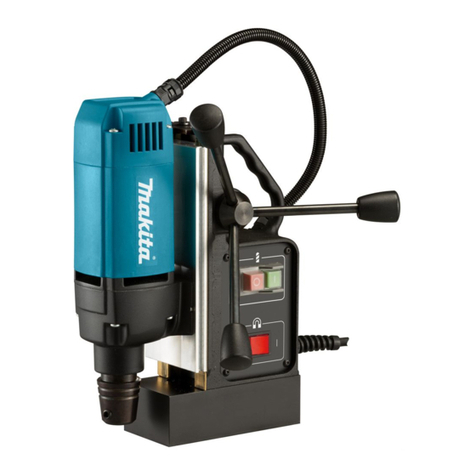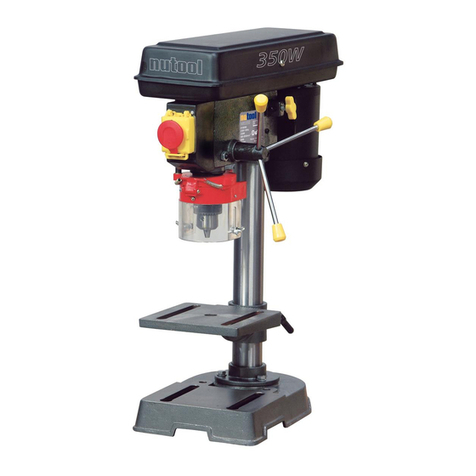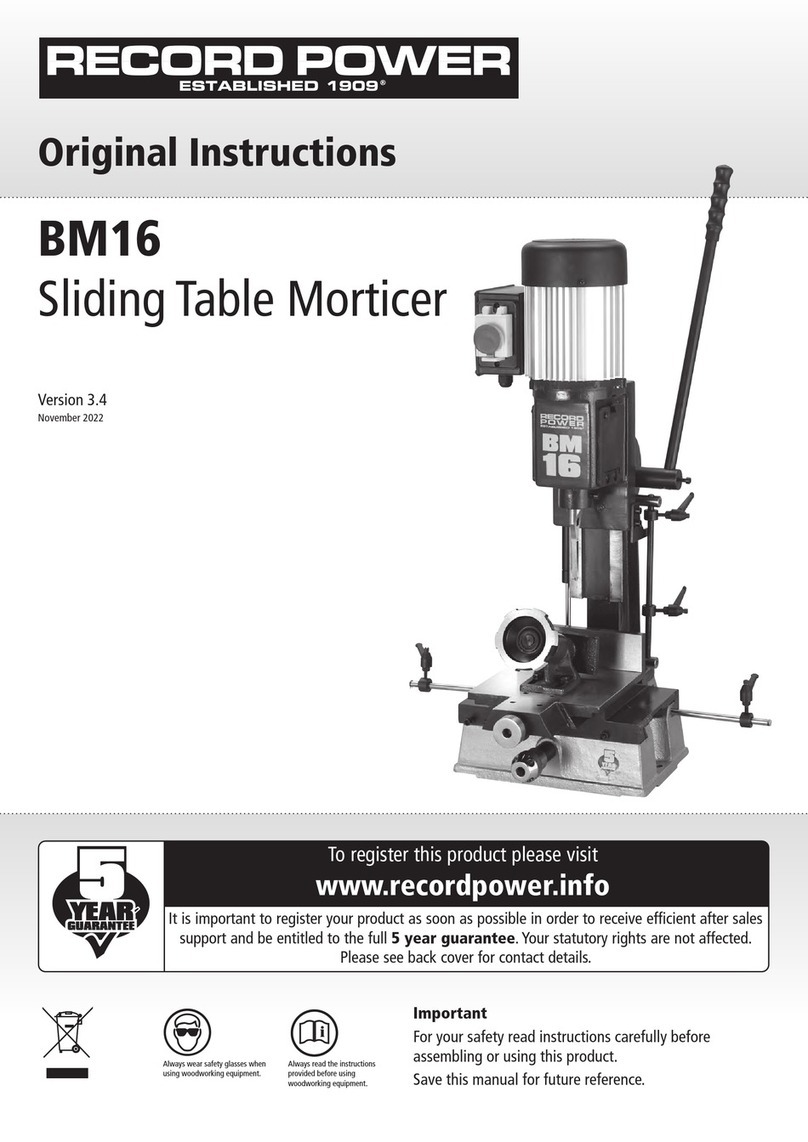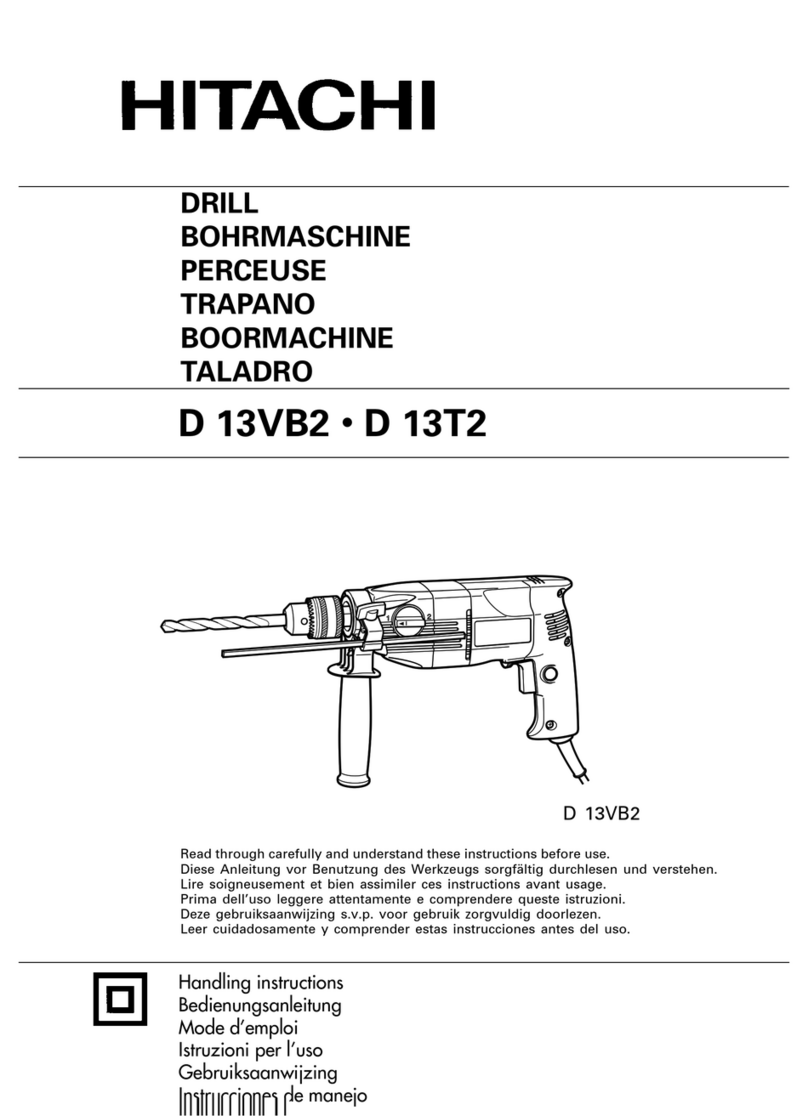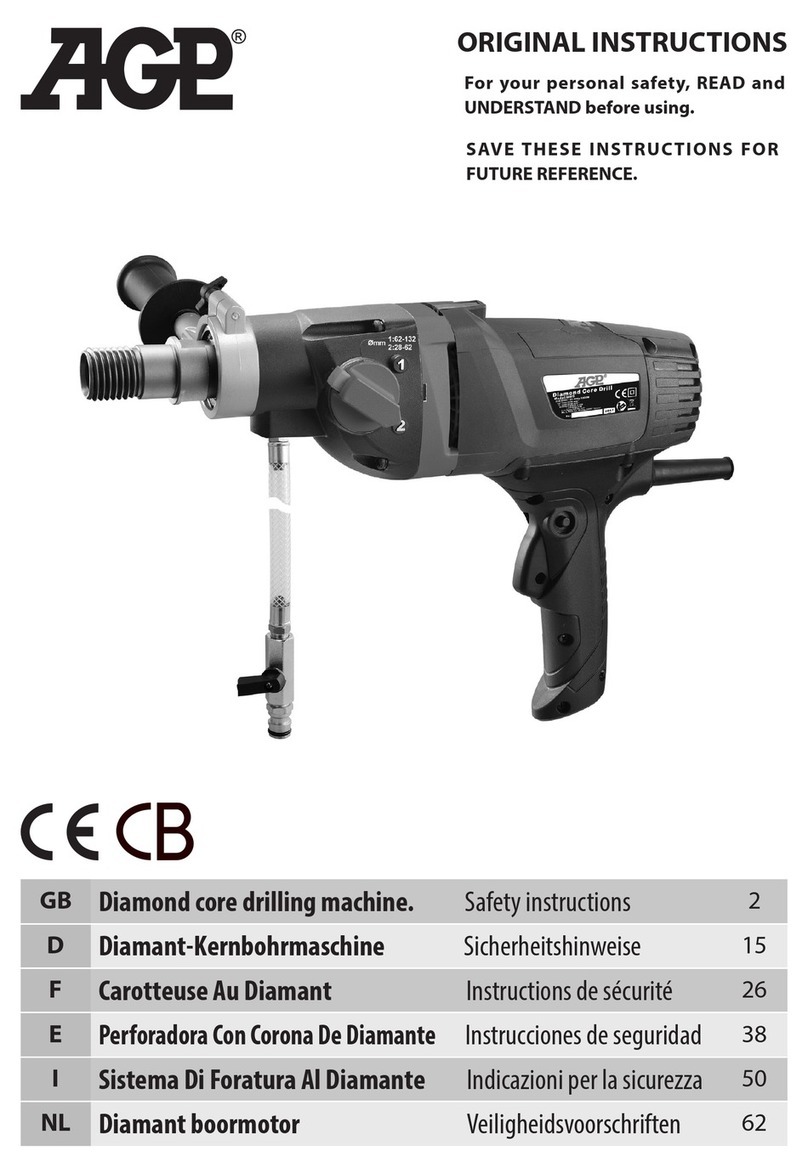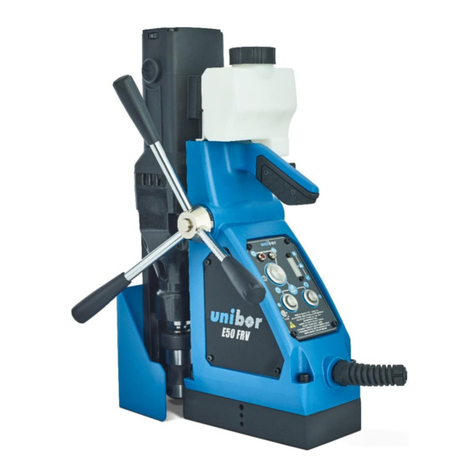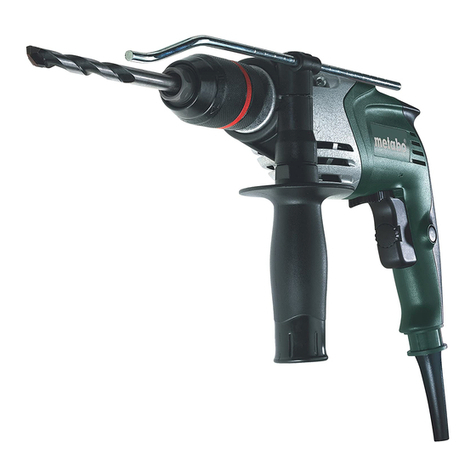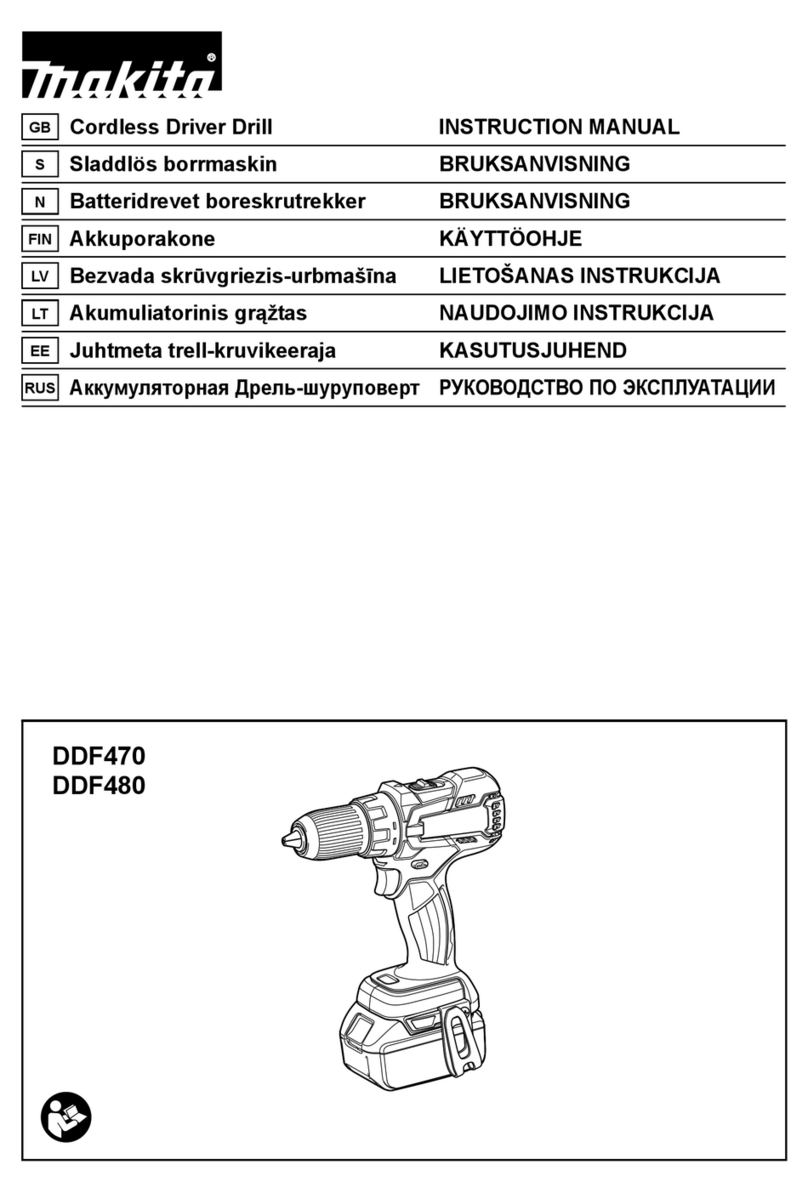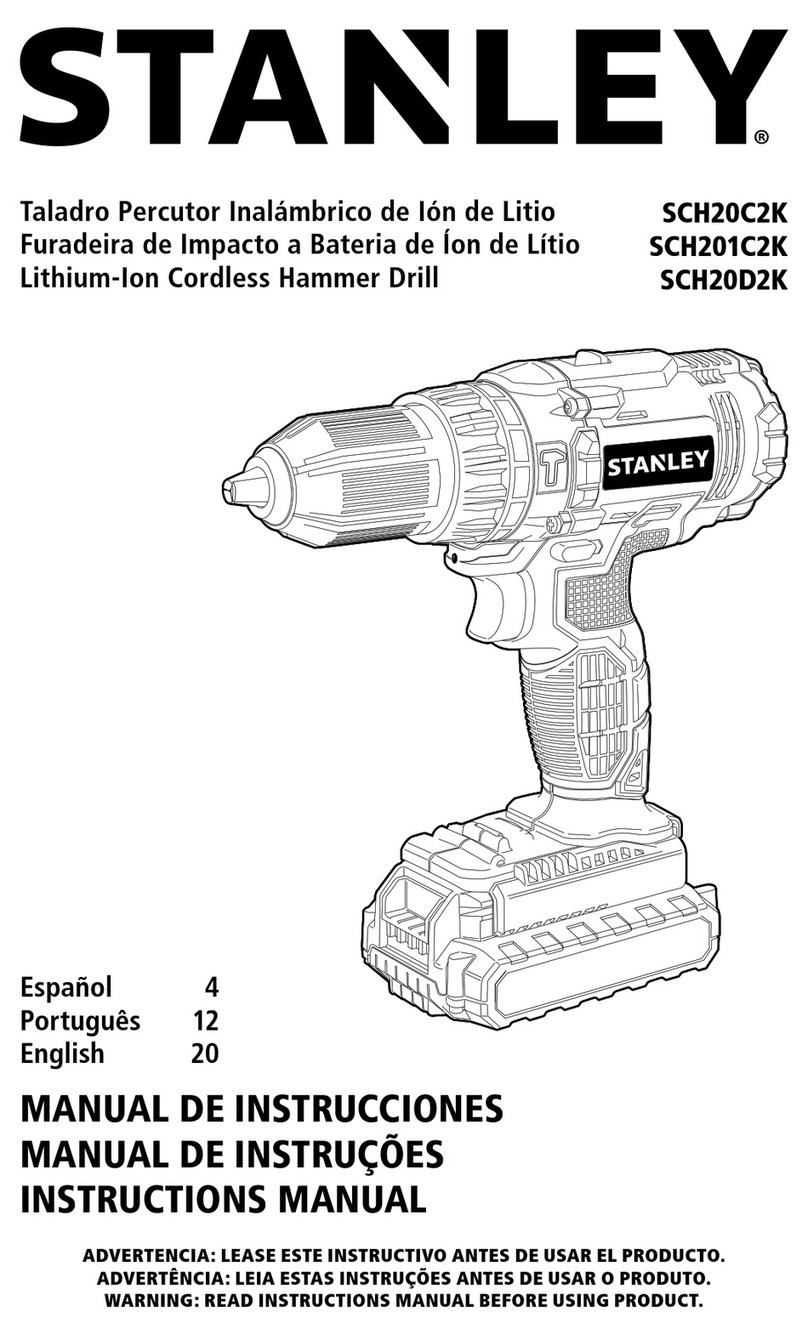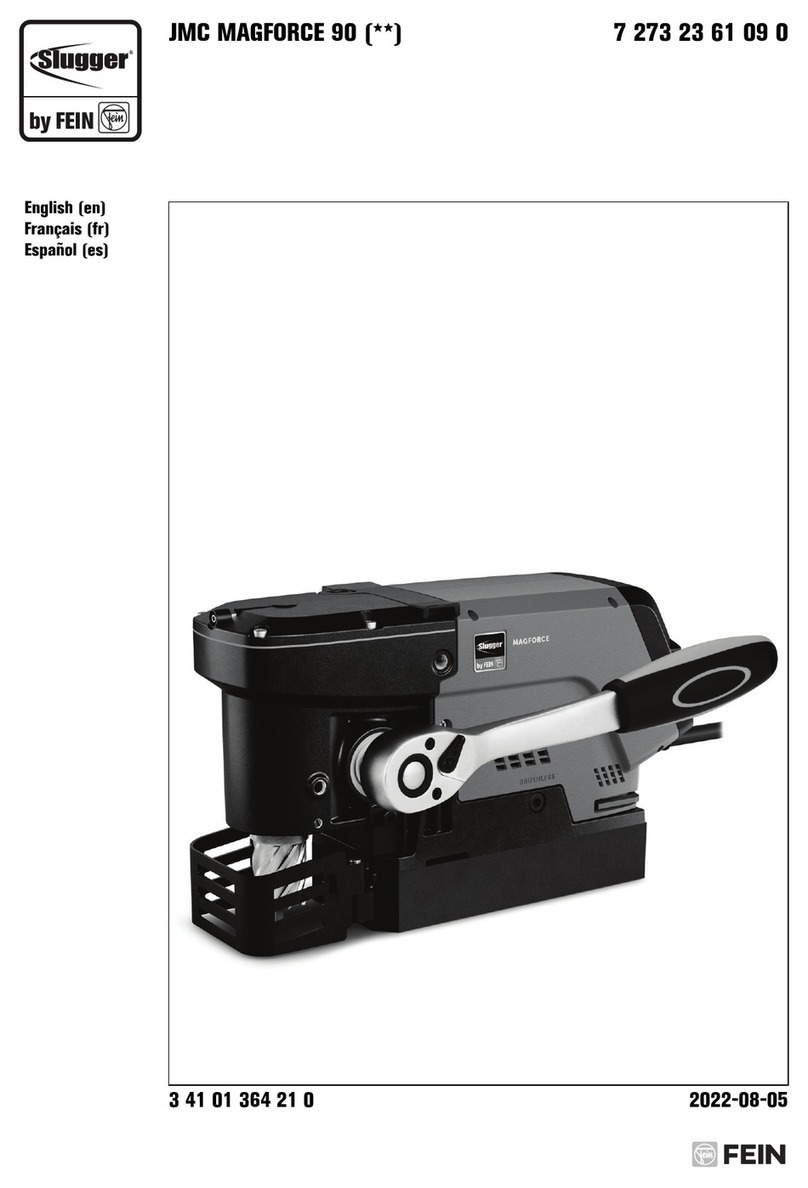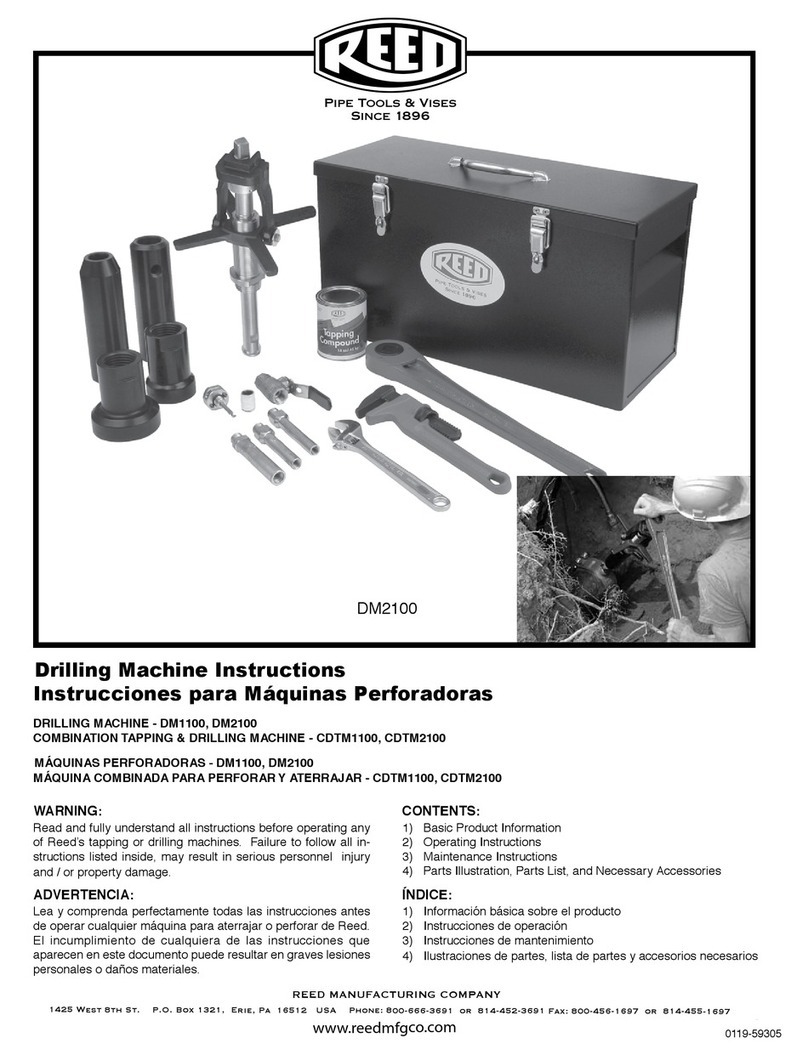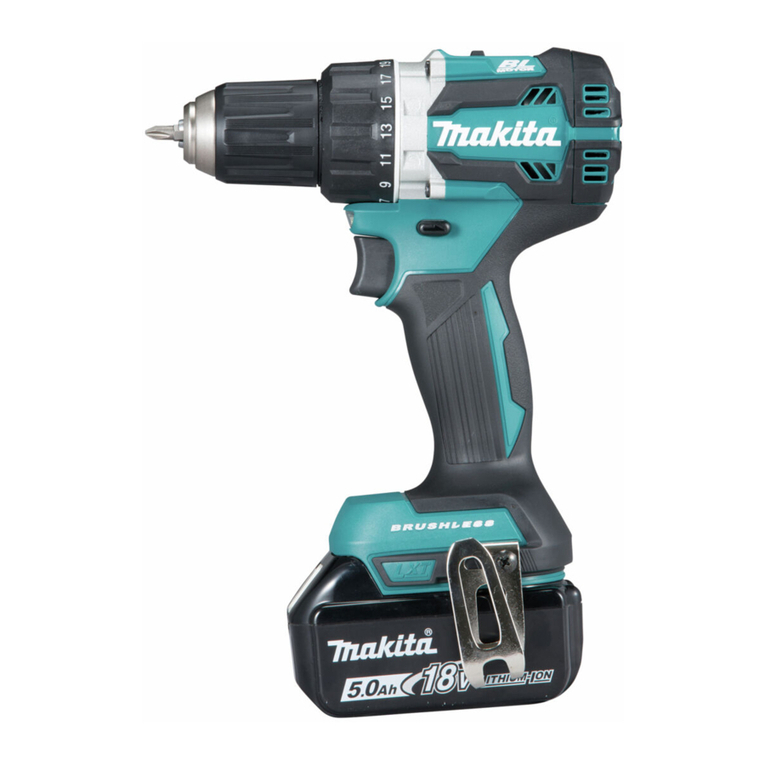Genio 050180 User manual

CORDLESS DRILL
User Manual EN
050180 User Manual EN.indd 1 12/9/16 9:52

2
B1
B2
B4
B3
B5
11
16
2
3
9
6
1
2
3
8
9
7
Lo
Hi
4
4
4
5
5
8
050180 User Manual EN.indd 2 12/9/16 9:52

3
1 Description of the tool
1 Selection Torque
2 Inverter Switch
3 ON/OFF
4 Battery
5 Pushlock Button
6 Selection for 1st or 2nd
7 Quick Change Mandrel
8 Battery Charger
9 LED
10 Integrated Magnetic holder
B6
B8
B7
77
7
10
a
b
050180 User Manual EN.indd 3 12/9/16 9:52

4
2 Intended use
The tool is designed for screwing and unscrewing as well as for drilling in wood, metal, ceramic and plastic
materials. This tool should not be used for purposes other than those described above.
3 Before use
Before turning on the cordless drill, read the following notes:
1Charge the battery with the charger provided with the tool. A fully discharged battery recharges in one hour.
2Use only appropriate bits and tip screwdrivers.
3When screwing and drilling into walls, check for power lines, gas or water hidden.
4 Use
4.1. Charging the battery (B2-B3)
1Pull the battery (5) of its abse, resting on the bottom base.
2Check if the power voltage on the rating plate corresponds to the voltage available.
3Installthebatteryintothecharger.TheredLEDindicatesthatthebatteryischarging.Onceloaded,theredLEDturns
off and the green LED stays on continuously. The load is lasted 1 hour (approx.) in case of a fully discharged
battery.
4During charging, it is normal for the battery to warm slightly. If you can not charge the battery, check:
>That the socket has voltage.
>That the charger contacts are reliable.
If you still can not load, please send to our post-sales service:
>The charger
>The battery
It is necessary to recharge the battery in time in order to ensure good durability. This is absolutely necessary from
the moment you notice that the power of the cordless drill decreases.
Never discharge the battery completely. You can damage it!
CAUTION: recharge the battery regularly, for example once every six months.
4.2. Setting the torque (B4)
The drill is provided with a mechanical adjustment of torque. This can be adjusted to a size screw for its adjustment
wheel. The torque depends on several factors:
> The type and hardness of the material to be treated.
> The type and length of the screws used.
> Of the requirements to be met by bolted joints.
If the torque is reached, a chirp indicates that the uncoupling has been done. Attention! Do not regulate the
adjusting ring by the torque until the machine stops.
050180 User Manual EN.indd 4 12/9/16 9:52

5
4.3. Drilling (B4)
To drill, put the adjustment wheel for the torque in the last grade “drill”, in grade “drill” the safety clutch is
deactivated. When drilling, the maximum torque is available.
4.4. Switch the direction of rotation (B5)
The slide switch over the on/off switch allows to choose the rotation direction of the drill / driver with battery and
prevent accidental starting. You can select clockwise rotation or leftward. To prevent damage to the gear, do not
change the direction of rotation if the machine is running. In the case that the slide switch is in center position,
switch on / off crashes.
4.5. Switch on / off (B5)
The switch on / off allows you to adjust the speed continuously, depending on the intensity with which the switch
is pressed.
4.6. Switching speed 1 to speed 2. Fig. 4 / Item 6 (B7)
Note: Press the 6 gearshift lever only in the stability of the device.
In the first gear (gear selector position 6 in 1) a speed of 400 min-1 and torque is achieved. This setting is suitable
for all fastening applications.
In the second gear (6 speed selector switch position: 2) a speed of about 1400 min-1 is achieved to carry out
drilling operations.
4.7. Display battery status (B8)
Three color LEDs indicate the status whenever the ON / OFF button (4) is pressed.
> All LEDs are lighted: the battery is fully charged.
> Yellow and red LEDs lighted: the battery has enough charge.
> Red LED lighted: the battery is empty, you should charge it.
4.8. LED display (B8)
The LED (10) light can illuminate the screwing and unscrewing area under unfavorable lighting conditions. The LED
(10) light illuminates automatically, at the time the switch on / off (4) is pressed.
4.9. Tool change (B9)
ATTENTION! For works (eg changing tools, maintenance, etc.) on the cordless screwdriver, put the
switch in the direction of rotation (3) in middle position.
> The cordless screwdriver is equipped with a quick coupling mandrel (9) with automatic lock on.
> Unscrew the mandrel (9). The overture of the mandrel (a) must be large enough to house the connector
(drill or screwdriver).
> Select the appropriate tool. Put the connector as far as possible from the overture of the mandrel.
> Adjust the mandrel and then check if the connector is well supported.
4.10. Screwing
Use preferably automatic centering screws (eg Torx, Phillips head) to ensure complete safety work. Ensure that
the shape and size of the screw are appropriate. Perform rotation torque control as described above: depending
on the size of the screw.
050180 User Manual EN.indd 5 12/9/16 9:52

5 Technical specifications
Power 12V Li-ion d.c./1,3Ah Li-ion
Gear 1 0 to 400 U / min
Gear 2 0 to 1400 U / min
Level rotation coupling 18 + 1
Max. torque (soft / hard) 23Nm
Rotate to the left / right Yes
Coupling capacity mandrel 1-10mm
Charge voltage, battery 12.5 V D.C.
Charging current, battery 1500 mA
Battery charger voltage 100-240V~/ 50-60 Hz
Duration of load 1 h
Noise and vibration Noise and vibration values have been determined according to EN
60745.
LpA sound pressure level 61.8 dB (A)
KpA Imprecision 3 dB (A)
LWA Sound power level 72.8 dB (A)
Kwa imprecision 3 dB (A)
Use noise protection.
Exposure to noise can lead to loss of hearing.
Vibration total values (vector sum of three directions) have been determined according to EN60745.
Metal drill
Vibration emission value ah0.495 m/s2
Imprecision K 1,5 m/s2
Pierced without percussion
Vibration emission value ah<2,5 m/s2
Imprecision K 1,5 m/s2
050180 User Manual EN.indd 6 12/9/16 9:52

7
6 Cleaning and maintenance
Remove from the wall outlet before all cleaning works.
6.1. Cleaning
>Keepprotectiondevices,airventsandthe motor housing asclean(dustfree) as possible. Cleantheappliancewith
a clean cloth or clean with compressed air at low pressure.
> We recommend cleaning the appliance directly after each use.
>Cleanthedeviceregularlywithadampclothandalittlesoap.Donotuseanycleanerordetergent;Theycandamage
the plastic parts of the tool. Ensure that no water comes into the device.
6.2. Maintenance
Recharge the battery regularly, for example once every six months.
7 Repairs
Only use accessories and parts recommended by the manufacturer. If this is damaged, despite the quality control
and care of the machine, repair the tool only in a specialized technical service.
If the power tool is damaged, it must be repaired by the manufacturer or its representative or a qualified electrician
to avoid any risk related to security.
8 Safety recommendations and warnings
This device complies with the prescribed recommendations for safety devices.
Read the instructions carefully before connecting the tool.
Improper use can cause injury or damage. People who are not familiar with the operation of the device should
not use it.
Keep the manual in a safe place. Children and teenagers should not use the tool.
9 General safety recommendations
General safety recommendations for the tool.
WARNING: Read all safety warnings and all instructions. Not following the warnings and
instructions may result in electric shock, fire and / or serious injury.
Save all warnings and all instructions for future reference.
The term “tool” in the warnings refers to your electrical power tool connected to the current (with cord) or battery-
powered tool (without power cable).
9.1. Workspace Security
a) Keep the area clean and well lit up. Cluttered or dark areas can cause accidents.
b) Do not use power tools in explosive environments, eg in the presence of flammable liquids, gases or dust. Power
tools create sparks which may ignite the dust or fumes.
c) Keep children and people away during the use of the machine. Distractions can cause you to lose control of
the tool.
050180 User Manual EN.indd 7 12/9/16 9:52

8
9.2. Electrical safety
a) It is necessary that the power tool plugs are adapted to the base. Never modify the plug in any way. Do not use
adapters with earthed tools. Unmodified plugs and adapted bases reduce the risk of electric shock.
b) Avoid body contact with earthed earth as pipes, radiators, stoves and refrigerators. There is an increased risk of
electric shock if your body is in contact with grounded surfaces.
c) Do not expose power tools to rain or wet conditions. The penetration of water into a tool increases the risk of electric shock.
d) Do not misuse the cable. Do not use the cord for carrying, pulling or unplugging the tool. Keep the cord away
from heat, oil, edges or moving parts. Damaged or entangled cords increase the risk of electric shock.
e) When operating a tool outside, use an extension cord suitable for outdoor use. Using a cable suitable for
outdoor use reduces the risk of electric shock.
f) If it is necessary to use the tool in a location with moisture, use a secure supply with residual current device
(RCD). The use of an RCD reduces the risk of electric shock.
9.3. Security staff
a) Be aware of what you are doing and use common sense while using the tool. Do not use a tool when you are
tired or under the influence of drugs, alcohol or medication. A moment of distraction in the use of a tool can cause
serious personal injury.
b) Use safety equipment. Always wear eye protection. Safety equipment such as dust masks, non-slip safety
shoes, helmets or acoustic protection used in appropriate conditions reduce injuries.
c) Avoid accidental starting. Make sure that the switch is in the off position before plugging in to power or battery,
collect or transport. Carrying tools with your finger on the switch or plugging the machine with the button in on
position can cause accidents.
d) Remove any adjusting key before turning the tool on. A key left attached to a rotating part of the tool may result
in personal injury.
e) Do not rush. Maintain proper footing and balance at all times. This allows better control of the tool in unexpected situations.
f) Dress appropriately. Do not wear loose clothing or jewelry. Keep hair, clothing and gloves away from moving
parts. Loose clothing, jewelry or long hair can get caught in moving parts.
g) If devices for connecting equipment for extraction and dust collection are supplied, make sure they are
connected and properly used. Use of dust collection can reduce risks due to dust.
9.4. Use and maintenance of the tool
a) Do not force the tool. Use the right machine to the application being performed. A suitable tool will do the job
better and more safely if used for the purpose for which it has been built.
b) Do not use the tool if the switch does not allow to turn it on or off. Any machine that can not be controlled by
the switch is dangerous and must be repaired.
c) Disconnect the power source supply or battery block machine before changing accessories or before storing the
machine. These preventive safety measures reduce the risk of accidental starting of the machine.
d) Keep the tool off away from children and do not allow to be used by people who are not familiar with the
machine. Tools are dangerous in the hands of inexperienced.
e) Make sure the machine maintenance and moving parts are not aligned or blocked, that it has not broken parts
or any other condition that may affect the operation of the tool. In case of damage, take the machine to a repair
service before using it again. Many accidents are caused by poorly maintained machines.
f) The machines used for cutting with sharp pieces that have had good maintenance are less likely to become
blocked and are easier to control.
050180 User Manual EN.indd 8 12/9/16 9:52

9
g) To use the machine, accessories and blades, etc. according to these instructions, taking into account the
working conditions and the work to be done. The use of the machine for operations other than those provided can
lead to dangerous situations.
9.5. Using machines with battery and precautions for use
a) Do not use any other charger than the one specified by the manufacturer. A charger that fits to a type of battery
can cause a risk of fire when used with other types of batteries.
b) Do not use tools with batteries other than those specified. The use of any other type of battery may create a risk
of injury and fire.
c) If the batteries are not used, keep them away from other metal objects such as clips, coins, keys, nails, screws
or other small objects that can lead to a connection from one terminal to another. Short-circuiting the terminals of
a battery can cause burns or fire.
d) In bad conditions, liquid may be ejected from the battery; avoid any contact. In case of accidental contact, flush
with water. If the fluid comes into contact with eyes, seek medical assistance. The ejected battery fluid may cause
irritation or burns.
9.6. Care and Maintenance
a) Repairs must be performed by a qualified expert, using only identical replacement parts. This will ensure that
the safety of the tool is maintained.
10 Special safety recommendations
> Hold the tool by insulated gripping parts while performing an ongoing operation in which the cutting element or
screw may contact hidden wiring. Contact with a wire “under stress” can put the metal parts of the power tool
exposed “under stress” and cause an electric shock to the operator.
> Use appropriate detectors in order to show the hidden supply ducts or consult local companies. Contact with
electrical lines can cause a fire or electric shock. Damage to a gas line can cause an explosion. Drilling a water
pipe can cause damage.
> Stop the appliance immediately when the tool blocks up. Expect coupling reactions that can cause major
consequences. The tool crashes if:
The appliance is overloaded
If you get stuck in the piece on which you are working
> Hold tightly the portable electric tool. Because of the unscrewing or screwing, may have, high reaction instantly.
> Fix the piece that is going to be worked on. A piece well-set or fixed in a vise piece is fixed more securely than held
in hands.
> Keep workspace clean. Mixtures of materials are particularly dangerous. Dust from light metals can be
explosive or flammable.
> Beforeputtingoffthe portableelectrictool, waituntilit iscompletelystopped. Thereisa riskthatthe machineblocks
up, which represents a loss of control over it.
> Do not open the battery. Risk of short-circuit. Protect the battery from heat sources such as direct exposure to sun
and heat. There is a risk of explosion.
> Vapors can escape in case of damage and improper use of the battery. Ventilate the workplace and in case of
discomfort, consult a doctor. Vapors may pose irritation in the airways.
> Ifthe batteryis defective,liquid cangooutandcomeintocontactwith nearbyobjects. Controlthe elementsaffected.
Clean or change them, if necessary.
050180 User Manual EN.indd 9 12/9/16 9:52

10
11 Explanation of symbols
Respect all symbols in this manual and on your tool. Remember these symbols and these signs, you can work
better and more safely with the tool if you know to correctly interpret the signs and symbols.
Attention
Read the user manual before using
Wear protective eyewear
Hearing protection
Resistant gloves
When working with materials that produce dust, always use respiratory protection.
According to applicable essential safety standards of the European Regulations.
The devices used are materials, so they should not be deposited with household garbage! Please
help by collaborating to protect resources and the environment and to deposit these products
through relevant recycling services, if any.
12 Environmental protection
The devices used are materials, so they should not be deposited with household garbage!
Please help by collaborating to protect resources and the environment and to deposit these products
through relevant recycling services, if any. For questions on this matter, please contact your local
council or a specialized site.
13 Certification
The tests have been carried out in accordance with following standards:
EN 60745-1:2009/A11:2010
EN 60745-2-1: 2010
EN 60745-2-2: 2010
050180 User Manual EN.indd 10 12/9/16 9:52

11
Annotations
050180 User Manual EN.indd 11 12/9/16 9:52

BOSSAUTO INNOVA, S.A.
Polígono Industrial Valldoriolf
c/ Thomas Edison, 16
08430 La Roca del Vallés. Barcelona. España
tel.: +34 938 604 923 / +34 902 100 667
fax: +34 938 712 336 / +34 902 363 047
www.bossauto.com
050180 User Manual EN.indd 12 12/9/16 9:52
Table of contents
